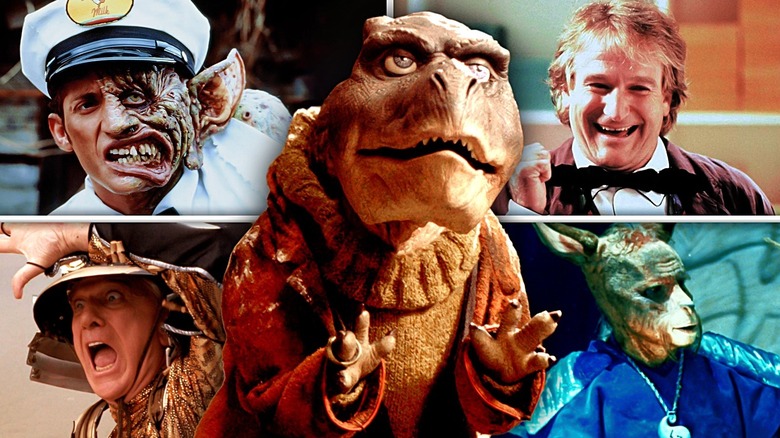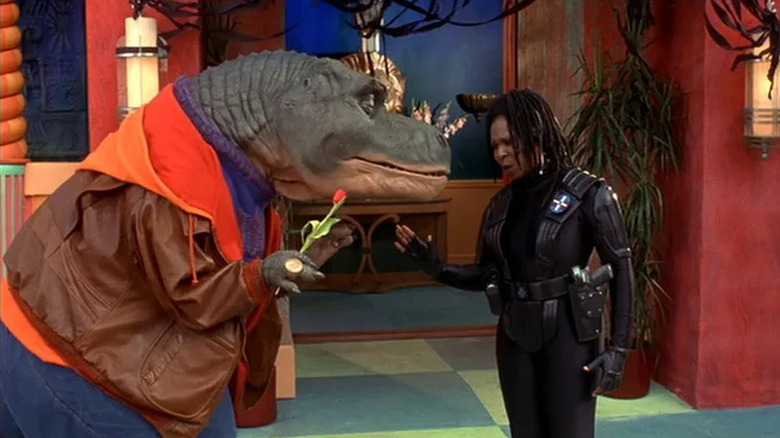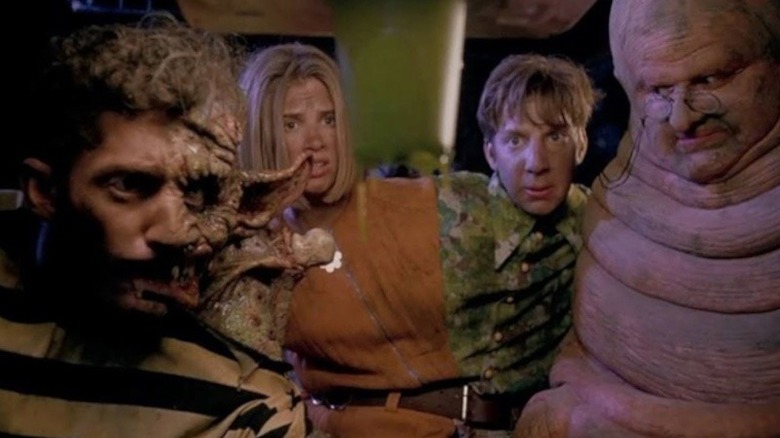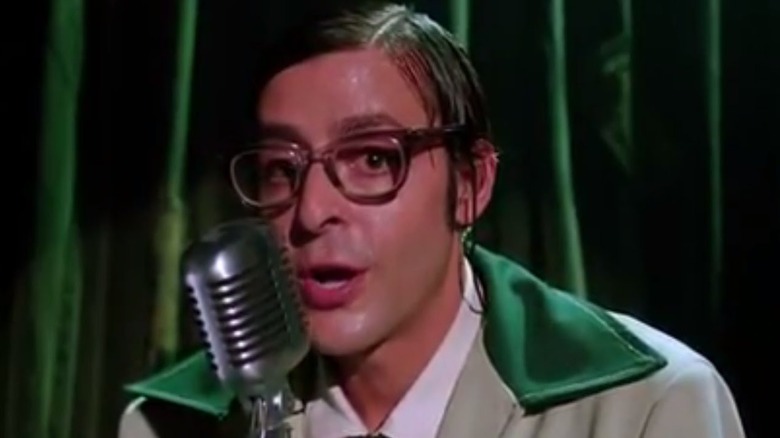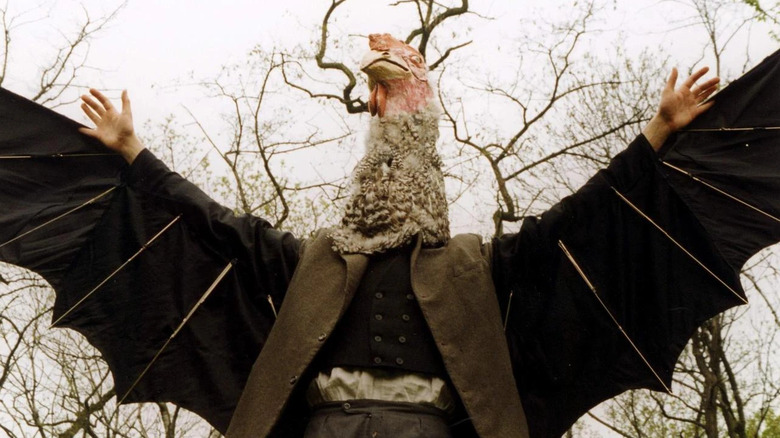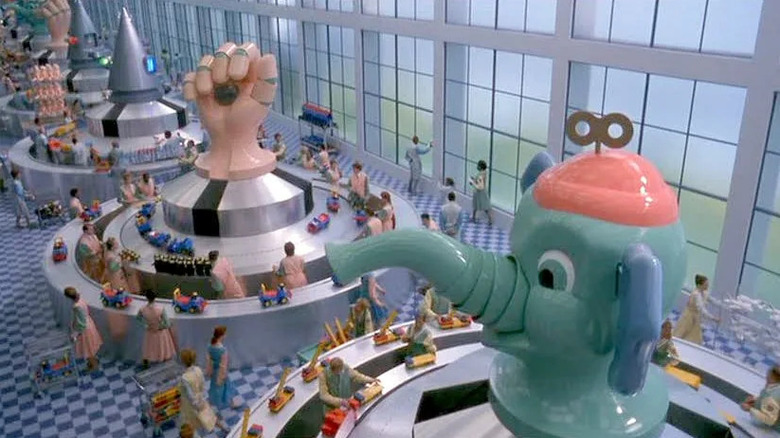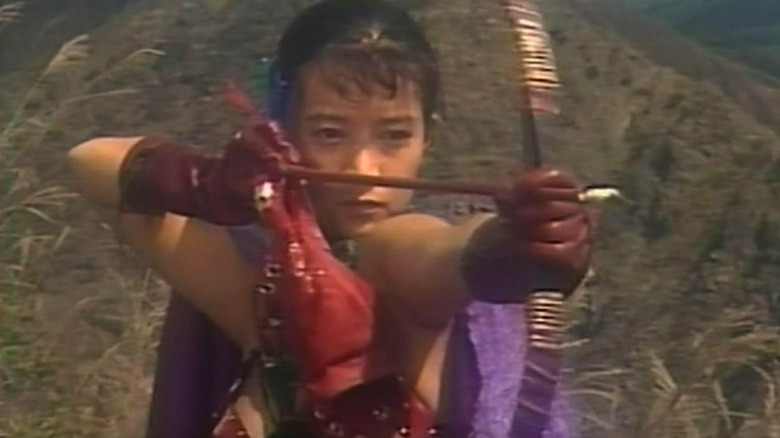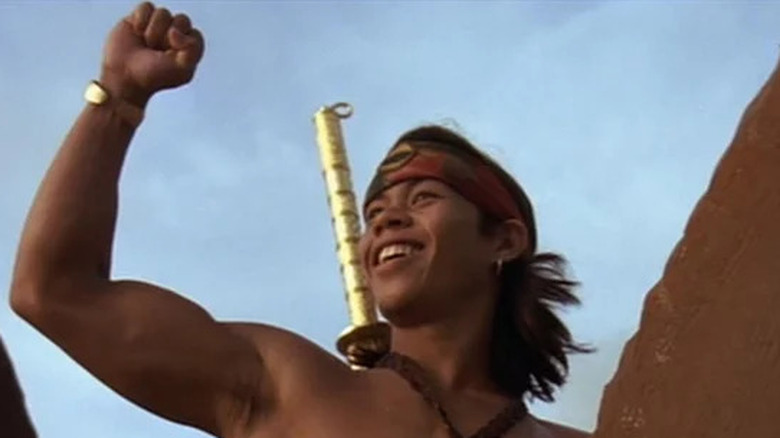12 '90s Movies You Won't Believe Are Real
The 1990s were an important era for cinema. Massive hits like "Jurassic Park" and "Titanic" came out during the decade, redefining the blockbuster for a new generation. The erotic thriller had become one of the most popular genres of "adult" films by this time, unleashing a slew of titillating ideas about gender roles into the mainstream. Independent films were a force to be reckoned with, and new voices entered the scene, including the filmmakers involved in the New Queer Cinema movement. Many consider the final year of the decade cinema's very best, perhaps the result of these industry trends.
But while the landscape of Hollywood in the '90s produced many beloved, critically acclaimed movies, it also produced some of the most bizarre films of all time. The independent cinema boom meant low-budget films were more common than ever, welcoming ambitious weirdos into the fold, and Hollywood execs continued to make some very odd choices in the name of the dollar.
If you're looking for strange, you're in the right place. What follows is a roundup of '90s movies that may prompt questions like, How did this film get made? Why did this film get made? We might not be able to answer all these queries for you, but in many cases, their inexplicability is exactly what makes them so intriguing.
Baby Geniuses
Movies in the '90s were all about putting children in harm's way. From Kevin's perilous staycation in "Home Alone" to the babynapping in "Baby's Day Out," something strange was in the water. 1999 saw the release of "Baby Geniuses," the pinnacle of this '90s weirdness. Kathleen Turner plays Dr. Elena Kinder, and Christopher Lloyd plays Dr. Heep. These evil scientists run BabyCo, an infant care company. They discover that before the age of two, babies can speak to each other in a secret language and possess Universal Knowledge. Dr. Kinder and Dr. Heep run an underground lab where they study babies and try to harness their powers. When one genius baby escapes and tries to free the other babies, chaos ensues.
Does this unhinged plot result in anything resembling a good movie? No, it does not. The film was universally panned by critics, who found it unfunny and even creepy at times. Director Bob Clark employed newly available CGI technology to make the babies speak, similar to the mouth morphing used in "Babe." The uncanny CGI mouths and eerily grown-up dialogue do nothing to make the absurd plot any more believable. Intended as a comedy, "Baby Geniuses" became an oddly disturbing trainwreck.
Despite terrible reviews and a so-so box office showing, Sony released a sequel, called "Superbabies: Baby Geniuses 2," in 2004. Amazingly, the sequel received even worse reviews than the first film, which currently holds a 2% score on Rotten Tomatoes. "Superbabies" has that beat with an even 0%.
Warriors of Virtue
You don't have to like "Warriors of Virtue," but you do have to give it credit for taking such massive swings. Helmed by Hong Kong filmmaker Ronny Yu, who would go on to direct "Bride of Chucky" and "Freddy vs. Jason," the film follows Ryan Jeffers (Mario Yedidia), a boy who travels to a mystical planet called Tao. He encounters the Warriors of Virtue, a group of anthropomorphic kangaroos with magic powers. Ryan teams up with the warriors to defeat Komodo (Angus Macfadyen of "Braveheart" fame), an evil sorcerer set on planetary destruction.
If the plot sounds odd, wait until you see what the movie looks like. The warriors, played by men in kangaroo suits, are incredibly off-putting and kind of frightening. They're also dressed in different colored costumes a lá the "Teenage Mutant Ninja Turtles" or the Power Rangers.
At least "Warriors of Virtue" has a compelling origin story. Four Chinese-American brothers, all physicians with no filmmaking experience, came up with the hairbrained kangaroo idea. The film's $35 million budget (plus an extra $20 million for marketing) came from their father, Joseph Law, a successful toy manufacturer. Unable to pass up a good deal, MGM released "Warriors of Virtue" without spending a penny on the movie. The film was a flop, but what's a few million amongst family?
Theodore Rex
Just five years after securing an Academy Award for her role in the Patrick Swayze and Demi Moore flick "Ghost," Whoopi Goldberg starred in a film that earned her a Razzie nomination. (Goldberg actually "lost" the Razzie to Demi Moore that year.) In "Theodore Rex," Goldberg plays Katie Coltrane, a street-smart cop. Set in a world where humans and dinosaurs not only coexist but also communicate, Coltrane's new partner is a Tyrannosaurus named Thedore Rex (George Newbern). Their mission? To stop a dinosaur killer and prevent the world from falling into another ice age.
Goldberg was not a happy camper on set, and not just because she was starring alongside a talking dinosaur. Goldberg didn't want to star in"Theodore Rex" at all, but producers successfully proved –- using an answering machine message -– that she agreed to sign on in the early stages, so she was legally forced to star in the movie. Her instinct to back out proved to be the right one, as the film was both a critical and a commercial failure. In fact, it didn't even make it to theaters and was released direct-to-video instead. "Theodore Rex" is the kind of movie that begs the question, How did this get made? That story is arguably more interesting than the astounding trainwreck that is the feature film.
Freaked
A film that takes absurdity as its central organizing force, fans of "Freaked" love it precisely for its strangeness. Directed by Tom Stern and Alex Winter of "Bill & Ted's Excellent Adventure" fame, who also stars in the film, "Freaked" features a cast of eccentric characters. Winter plays conceited former child star Ricky Coogin, who agrees to promote a fertilizer developed by a shady corporation called Everything Except Shoes. As part of the deal, Ricky and his friend Ernie (Michael Stoyanov) travel to South America and become trapped on a mutant freak farm run by a mad scientist.
The freaks at the farm include mutants such as a human worm, a half-man, half-cow, Dog Boy (played by an uncredited Keanu Reeves), and a pair of evil eyeballs with legs. The mad scientist turns Ricky and his crew into mutants as well, forcing them to participate in his literal freak show.
Though it achieved some buzz on the film festival circuit, "Freaked" was only shown in two theaters following personnel changes at the studio. Despite its failure to launch, "Freaked" slowly gained an audience on home video, and has since become a cult classic. In fact, a 4K restoration on Blu-Ray will be available later this year, giving the unfairly neglected film a new life.
The Dark Backward
When it comes to elevator pitches, Adam Rifkin's 1991 film "The Dark Backward" has a pretty good one. What if a garbage man who wanted to be a stand-up comedian grew a third arm out of his back? What then? "The Dark Backward" answers that question with gleeful eccentricity and a whole lot of obscenity. Judd Nelson plays Marty Malt, our aspiring funnyman. His lackluster comedic stylings are encouraged by his best friend and fellow garbageman Gus (Bill Paxton), the only person who ever laughs at his jokes. When Marty inexplicably grows a third arm, Gus gets him an agent who uses this oddity to sell tickets.
The film's bizarre premise is brought to life by a surprisingly stacked cast. Along with Nelson and Paxton, whose demented energy propels the film, "The Dark Backward" features James Caan playing a quack doctor named Dr. Scurvy, Rob Lowe as Hollywood agent Dirk Delta, Lara Flynn Boyle of "Twin Peaks" as Marty's girlfriend, and legendary Las Vegas showman Wayne Newton as talent agent Jackie Chrome.
Rifkin wrote the script when he was 19, which may account for its reliance on gross-out humor. The film's over-the-top stupidity rubbed some viewers the wrong way and divided critics. However, like many of cinema's strangest creations, "The Dark Backward" has since developed a cult following and is a shoe-in for midnight movie screenings.
Conspirators of Pleasure
Known as the face of late 20th-century Czech surrealism, Jan Švankmajer's films combine various elements, from fine art to animation and puppets, to create a unique collage of images. His third feature film, 1996's "Conspirators of Pleasure," proudly flies its freak flag. The movie follows five people living in Prague, each with their own bizarre fetish.
A single man (Petr Meissel) builds a giant papier-mâché chicken inspired by his neighbor (Mrs. Loubalova). In turn, his neighbor builds a straw dummy of the man that she whips every night. A postwoman (Barbora Hrzánová) makes dough balls that she ingests through her nose and ears before bed. A newsstand owner (Jiří Lábus) obsesses over a TV news anchor (Anna Wetlinská) and builds a masturbatory machine in her owner. The TV anchor delights in having fish nibble at her feet while reading the news, while her husband, a policeman (Pavel Nový), steals things to make erotic sensory objects.
The film doesn't feature any dialogue, but each character has a distinct score that soundtracks their strange behavior. Švankmajer creates a tactile, sensory experience, using puppetry, textures, and sounds to engage the senses. As a perverted black comedy, the film subverts Eastern European puritanism and highlights the individuality of every human being.
Toys
An ambitious film that never quite comes together, Barry Levinson's "Toys" is the director's attempt at surrealism. Robin Williams plays Leslie Zevo, a childlike toymaker. When his father, the CEO of a toy company, dies, he puts his estranged brother in charge, relegating Leslie and his sister, Alsatia (Joan Cusak), to the factory floor. Their uncle, Army Lieutenant General Leland Zevo (Michael Gambon), begins building war machines disguised as toys. It's up to Leslie and Alastia to save the company before it's too late.
By far the most impressive element of the film, the sets in "Toys" are mesmerizing. Production designer Ferdinando Scarfiotti built massive, practical sets for the toy factory, as well as colorful, painted landscapes reminiscent of the sound stages of Old Hollywood. The film's Technicolor surrealism garnered two Oscar nominations, for Art Direction and Costume Design.
Unfortunately, the film's content doesn't live up to its visuals. The plot drags at times, and it isn't enough to fill the movie's two-hour runtime. The film's anti-military message is too convoluted and frightening for most children, while its nonsensical absurdity is a turn-off for many adults. A standout example of style over substance, "Toys" is best remembered as a visual spectacle rather than a quality film.
Legendary Panty Mask
The Japanese film "Legendary Panty Mask" doesn't make a lick of sense, and on paper, we can barely construct anything resembling a plot. The movie takes place in a western town filled with schoolgirls and gun-toting nuns. The nuns killed the male population of the town and teach the girls that all men are evil. The schoolgirls are led by a superhero named "Panty Mask," who dresses in a skimpy outfit and uses underwear as a mask while fighting the tyrannical nuns. Also, for some reason, the nuns pray at the altar of an ice statue of Jesus, which keeps their beer (stored in a coffin) cold.
Based on the "Maboroshi Panty" manga from prolific manga artist Go Nagai, the plot is nearly incomprehensible. The title character hardly ever appears, and the film features multiple musical numbers that have nothing to do with the story, including several renditions of "Row, Row, Row Your Boat." While some elements are the film are perplexing in a mildly diverting way, others are far more cringeworthy. For example, the movie includes a performance of the 19th-century nursery rhyme "Ten Little Indians," where the schoolgirls dress up in Native American costumes. In one jarring moment near the end of the song, a bartender shows up in horrific blackface. It's an utterly confounding film with no rhyme or reason, apart from the racist children's songs.
Prey of the Chameleon
Though it clearly draws from the genre, "Prey of the Chameleon" is far from the best erotic thriller. In fact, it's one of the worst. The film stars Daphne Zuniga, best known for her work on "Melrose Place." Zuniga plays an escaped mental patient and serial killer who takes on the identities of the people she kills. As the tagline reads: "She loves you. She kills You. She becomes you." For example, when she kills a nun, she becomes a nun until her next kill. (Whether she was in love with the nun or not remains unclear.) She sets her sights on J.D. (James Wilder), a listless wanderer and the ex-fiancé of Carrie (Alexandra Paul), the town sheriff.
The central plot device is quite silly, and it never seems like our sexy killer actually becomes her victims; she just dresses like them and bears a passing resemblance thanks to wigs and a little makeup. Believability aside, the film has its moments. It's not the tamest of erotic thrillers, nor is it the most explicit – the VHS cover reads "medium level sex and violence." Though it's silly, kind of stupid, and what you'd expect from a made-for-TV erotic thriller, its predictability doesn't lessen its entertainment value.
If you're wondering about the film's commitment to authenticity and logic, look no further than the movie poster, which features the tattooed back of a naked woman. The animal inked on her back? An iguana. Close enough.
Highlander 2: The Quickening
Often considered one of the worst movies ever made, "Highlander 2: The Quickening" makes an already strange film series even stranger. The first movie follows Connor MacLeod (Christopher Lambert), a soldier from the Scottish Highlands. After dying in the 16th century, Connor is resurrected, learning he's an immortal who can only be killed by beheading. After fighting in a secret war for centuries, Connor arrives at the Gathering in 1985, where immortals are promised a Prize. Connor survives the final battle and wins the Prize -– mortality.
And everyone lived happily ever after, right? Well, not quite. Though the first film gave Connor a storybook ending, producers didn't let that stop them from making a sequel that ignored the conclusion of the previous movie. "The Quickening" introduces one of the most bizarre retcons in cinema. Those guys weren't immortal men in kilts – they were aliens. Connor's new mission is to stop climate change, which involves resurrecting his buddy Ramirez. (Played by Sean Connery, Ramirez was an Egyptian immortal – now an alien – with a Spanish name and a Scottish accent.)
The Prize is no longer mortality, but rather a choice between living as a mortal on Earth or returning to their home planet. Though none of these plot changes make any sense, one point stands out as the most perplexing. None of the characters, including the patriotically-named Highlander, are actually Scottish, which sort of upends the premise of the entire story.
Surf Ninjas
It doesn't take much imagination to guess what the 1993 movie "Surf Ninjas" is about. Directed by "Lizzie McGuire" showrunner Neal Israel, the film follows teenager surfer Johnny (Ernie Reyes Jr.) and his younger brother Adam (Nicolas Cowan). Through their uncle, Zatch (played by Ernie Reyes Jr.'s father, Ernie Reyes Sr.), they learn that they're heirs to the throne of an Asian island nation called Patusan. An evil dictator, the metal-faced Colonel Chi (Leslie Nielsen), rules the country, so the brothers travel to their home country to defeat him.
"Surf Ninjas" features plenty of far-out plot points, but it's perfect for action-loving kiddos. Johnny learns he has super ninja powers, letting Reyes Jr., who worked as a stunt double on the "Teenage Mutant Ninja Turtle" films, show off his martial arts skills. His brother Adam can see the future through his SEGA Game Gear. This branded tie-in was no coincidence, as SEGA financed some of the film and developed a video game based on the movie. (The video game went into production before the film did, and came out before the movie's release.) Rob Schneider plays Johnny and Adam's dimwitted friend, who can't surf or fight. Though it might be too juvenile for serious-minded moviegoers, "Surf Ninjas" delivers on its zany premise, and then some.
The Cat
Gooey, campy, and wacky to the max, 1992's "The Cat" offers feline action like you've never seen it before. Directed by Hong Kong filmmaker Lam Ngai Kai, best known for his bloody cult classic "Riki-Oh: The Story of Ricky," the movie is not about animals, per se, but about aliens. Three extraterrestrial creatures have traveled to Earth to defeat an evil alien with the ability to possess human beings. One of these creatures, known as the General, takes the form of a black cat. An author, Wisely (Waise Lee), encounters the alien trio and sets out to discover their secrets.
That admittedly goofy premise doesn't properly express how ludicrous and over-the-top the film is. In the movie's most memorable sequence, the alien cat fights a large dog using martial arts moves. The scene, which features no human beings and a lot of puppet work, lasts nearly four minutes. The evil alien takes a fungus-like form, with lightning-filled prehensile limbs and a green bug-eyed face. The alien cat and its companions use glitter to travel to their home planet, and one of them walks through fire.
Having garnered a small cult following since its release, bootleg copies of "The Cat" were passed along among diehard fans for years. A remastered Blu-ray version of the film was announced earlier this year, giving "The Cat" a new lease on life and Hong Kong action lovers another niche masterpiece to add to their collections.
